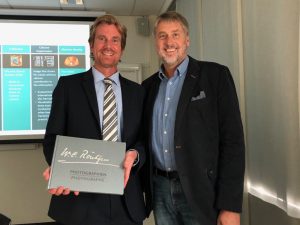
Marcus Drews (Philips) and Uwe Busch (ISHRAD)
The 7th scientific meeting of the International Society of Radiology was held on Oct 6 2018 in the Philips Museum, Eindhoven.
On the Friday before the lectures delegates were invited to visit the Customer centre of Philips in Best a few miles from the centre of Eindhoven where they were met by Marcus Drews International Business lead for CT for Philips and then shown the latest developments and prototypes of a range of healthcare products giving us all an insight into the future. It was like science fiction was turning into a true reality.
First the future and then the museum hosted the wide variety of lectures of the symposium the following day.
Frans Zonneveld opened the morning with a talk on ‘The Centre for radiological heritage in the Netherlands’ a collaborative effort with the Dutch society of Radiology to preserve its important history and heritage. The achievements over the last 3 years since its beginning were described.
Kees Vellenga talked on ‘Johan Wetheim Salomonson founder of the Dutch Society of Radiology in 1901’. Solomonson was appointed a professor of neurology and roentgenology in Amsterdam and was one of the first radiology professors in the world along with E Grunmach in Berlin. His contributions to radiology and the founding of the Nederlands cancer institute were described alongside the collaborations with Philips.
Next Hank van der Gugten spoke on ‘ Early Radiotherapy in Amsterdam 1913-1929’. A radiotherapy institute was founded in 1913 thanks to the visionary Dean Dr Jacob Rotgans of the University of Amsterdam. In 1914, 76 patients were treated. Research from the investigation of early treatment records were presented.
Next Dr Arpan K Banerjee spoke about ‘Dr Ian Donald and the sixtieth anniversary of his classic paper on ultrasound’. Donald was a maverick Professor of obstetrics and gynaecology in Glasgow, Scotland whose fruitful collaboration with the engineer Tom Brown led to his classic papers on the clinical uses of this technique and changed the way medicine was to be practised. Today it is almost impossible to imagine a world where doctors did not have ultrasound to aid them with the diagnostic processs.
In the early afternoon delegates were taken on a tour of the museum with its myriad of exhibits pertaining to the wide ranging manufacturing activities of the giant conglomerate Philips which all started with the manufacturing of the famous light bulbs which then diversified its portfolio to include electronic equipment eg radios , televisions, cassettes etc as well as of course the medical equipment.
The afternoon session kicked of with Renaat Van den Broeck talking about ‘The Belgian Radiology museum in a steady state of development’. The new features of the museum were discussed and the museum seems to be going from strength to strength.
Adrian Thomas then talked about the remarkable British radiobiologist Hal Gray who has the distinction of having had the unit of absorbed radiation dose named after him. His remarkable life was described and his career at Mount Vernon and the controversies at the Hammersmith Hospital were described with excellent illustrations. Sadly he died young aged 59 years
Frans Zonneveld then talked about the remarkable Albert Bouwers 1893-1972.
In 1920 this gifted physicist joined Philips Research Labs and never looked back. He made numerous discoveries and contributed to advances in product design including the Metallix xray tube, rotating anode, cascade generator ( which was bought by the Cavendish lab in Cambridge and enabled Cockroft and Walton to disintegrate nuclei)
He was appointed Professor of Physics of instrument design in Delft 1949-54 and had 140 patents.
He wrote several books including Achievements in Optics in 1946 and showered with honours including the gold medal of the RSNA in 1928 and the Rontgen-Plakette in Remscheid in 1963. He married in 1923 and had no children.
The final talk of the afternoon was delivered by Jan Hoffman titled ‘From Philips and co to royal Philips NV; The evolution of a company’
The talk gave us a history of the famous family which started the company in Eindhoven and how it evolved and diversified through the times. Initially there were 3 factories making lamps, glass and x-ray tubes. Philips had an artistic propaganda department in 1925 which produced all the posters and advertising long before branding became fashionable.
1n 1980 there were 420.000 employees worldwide. The company has consolidated and now has 74,000 employees but is still a major player in the healthcare sector and in product design.
The following day the delegates were given a tour of the Philips Historical Products museum slightly outside the centre of Eindhoven. Here one could view the vast product archive which Philips has amassed over the years. The range of products from light bulbs, transistor radio sets, televisons, amplifiers, phones ,microphones to medical equipment (not just radiological) built throughout the last century was on display for us all to marvel at and was a fitting conclusion to a very pleasant , convivial and informative weekend.
Thanks to Dr Uwe Busch, and all at the Eindhoven museums and the Philips team who helped make all this possible.
By Dr Arpan K Banerjee, Treasurer ISHRAD and Past Chairman British Soc for the History Of Radiology
